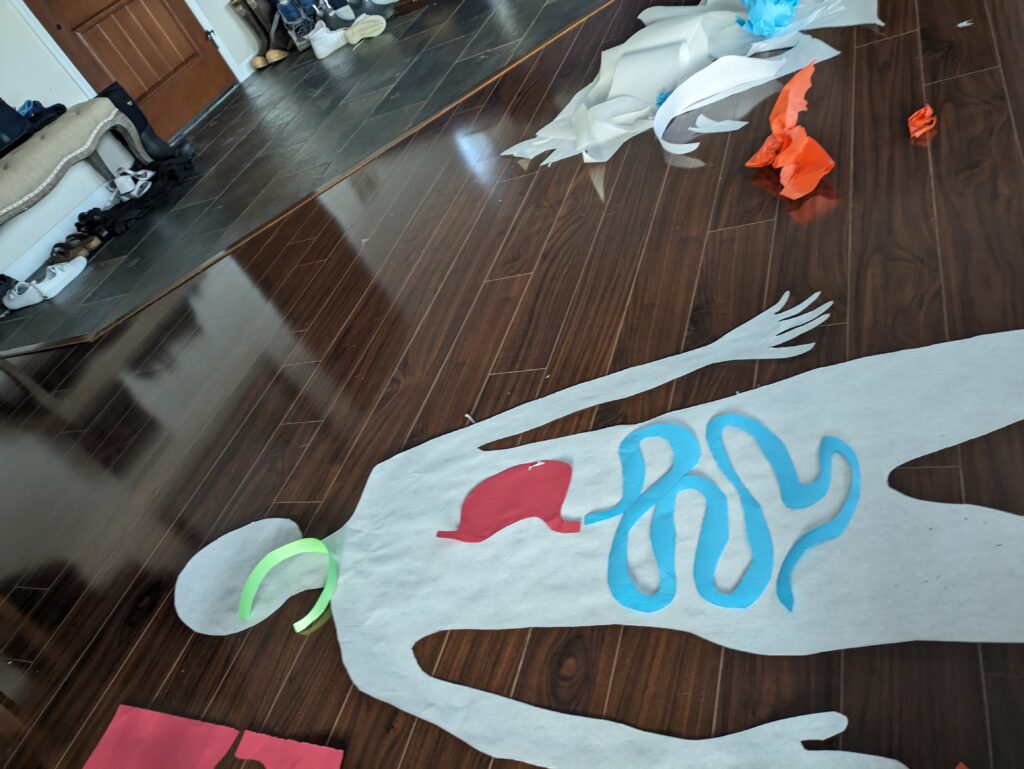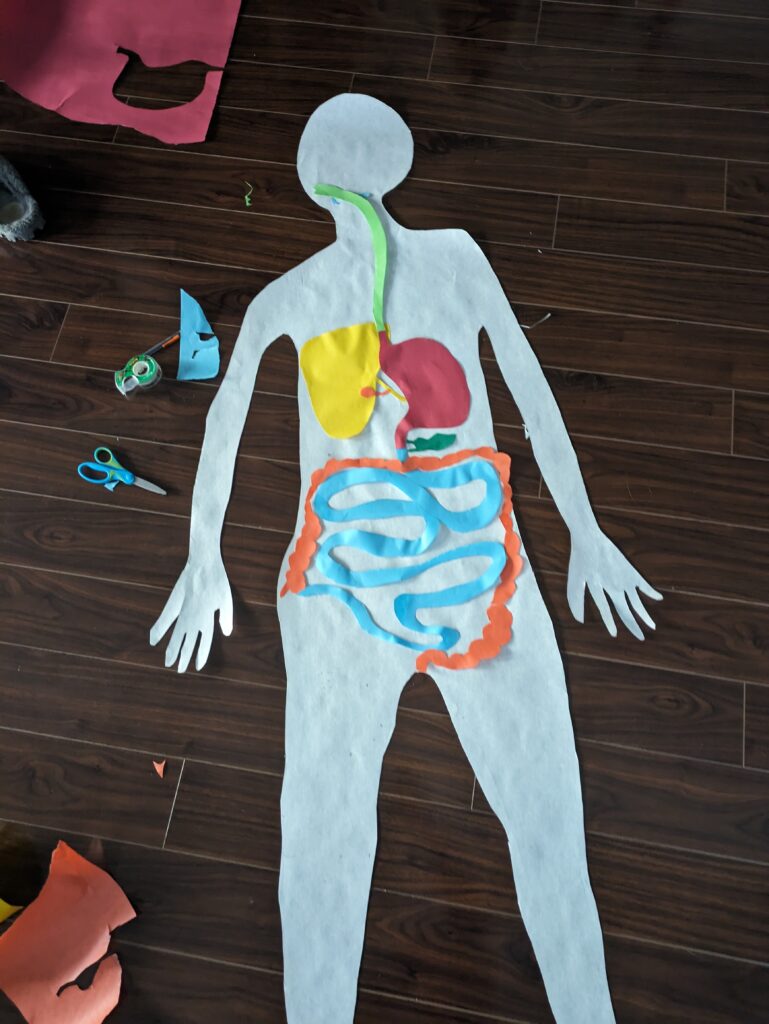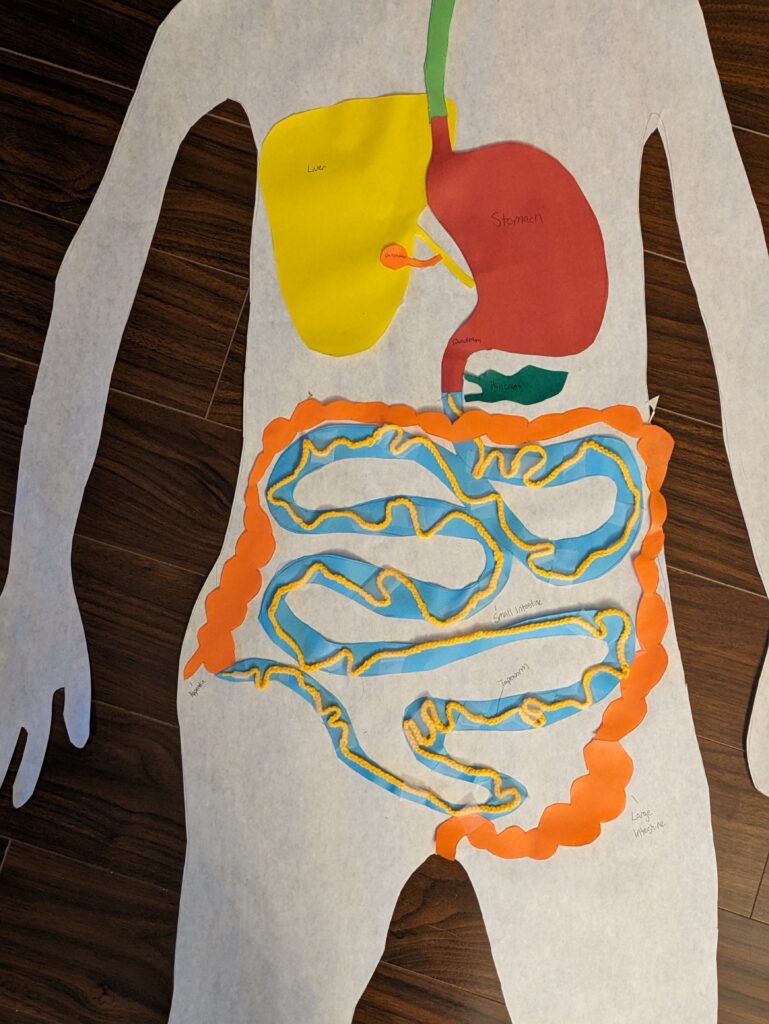Isabella Guy
Don Larson
Human Anatomy and Physiology
April 18, 2024
Tapeworms in the Digestive System
For my STEAM project, I researched tapeworms and how they affect the digestive system. I tied the topic of tapeworms to some of the course objectives related to the digestive system, specifically, the course objective relating to the digestive system’s functions and another course objective regarding knowing the order of organ function and path of food during digestion. A tapeworm is a type of parasite that is long and flat in shape and lives in a person’s digestive system. “Tapeworms get into the body when someone eats or drinks something that’s infected with a worm or its eggs” (Ben-Joseph n.d.). Of course, the tapeworm’s eggs must follow the digestion pathway. These eggs would most likely be consumed when someone eats infected pork, beef, or fish infected by the parasite. The process would start in the mouth and go down the esophagus and stomach before reaching the small intestine. Adult tapeworms will be found in the small intestine out of the large and small intestines. In the small intestine, the tapeworm feeds off passing food being digested. Symptoms of having tapeworms would be “mild nausea, diarrhea, belly pain, and weight loss” (Ben-Joseph n.d.). Pieces of the tapeworm may also be seen broken off in stool. “Tapeworms require single or multiple hosts to complete their life cycle. Infection of the host depends on the stage of the life cycle the tapeworm is in when the host becomes exposed” (Lesh & Brady, n.d.). The time of infection will determine what functions of the digestive system will be affected.
A worm in a person’s digestive system will definitely affect how food gets digested and the normal function of the digestive system. There are a lot of possible complications that go with tapeworms, and it really depends on what type of tapeworm a person has. Digestive system blockage can be an issue. Sometimes, an intestinal tapeworm will get so large that it can block passages in the digestive system like the bile ducts, pancreatic ducts, and even the intestines (Tapeworm Infection: Symptoms, Causes & Treatment, 2022). Another problem tapeworms can cause is if they are in the intestines for a while, the tapeworm can get so big that it blocks the appendix, which can lead to appendicitis (Tapeworm Infection: Symptoms, Causes & Treatment, 2022). “Appendicitis is the inflammation of the vermiform appendix” (Jones et al., n.d.). If a person is infected with a tapeworm, they may have issues absorbing vitamin B12. Fish tapeworms specifically absorb B12, leaving little to be absorbed by the small intestine, which can lead to anemia (Tapeworm Infection: Symptoms, Causes & Treatment, 2022). Tapeworm larvae can invade places like the eyes, lungs, liver, and even nervous system, which can cause major organ disruption, headaches, and even seizures (Tapeworm Infection: Symptoms, Causes & Treatment, 2022).
Treatment for tapeworms depends on whether it is a larval infection or a hatched worm infection. Treatment for a hatched tapeworm includes anti-parasitic drugs such as Praziquantel (Biltricide), Albendazole, and Nitazoxanide (Alinia), which can all be prescribed by your local doctor (Tapeworm Infection – Diagnosis and Treatment, 2023). The downfall is that these drugs will only kill the tapeworm itself but not the tapeworm’s larva. Treatments for larval cyst infections will vary depending on the location of the cyst. Anti-parasitic drugs like “Albendazole and praziquantel are used to treat larval cysts in the brain or central nervous system” (Tapeworm Infection – Diagnosis and Treatment, 2023). Surgery is also an option to remove larval cysts (Tapeworm Infection – Diagnosis and Treatment, 2023). Treatment depends on where in the digestive tract the tapeworm is and whether it is a larva or a hatched tapeworm.
For my medium, I created a cutout of a person and their digestive system on butcher paper. To start, I had my little brother lie on the butcher paper as I traced a human-like shape. My brother is 6’1, so the outline was pretty big. Once I had the basic shape, I could roughly estimate how big the organs of the digestive system would be with a bit of outside research. The organs of the digestive system were also cut out of butcher paper. I made one organ at a time, placing them on the human outline once I was done. When all the organs were cut out, I arranged them so they lined up as close as possible before I taped them down. Once I had a vision of how big my paper cut-out would be, I researched the size of the average tapeworm before crocheting my tapeworm visual. Tapeworms, on average, can be from 6 feet up to 30 feet long ((CDC – Dipylidium – Frequently Asked Questions (FAQs)). I decided to make a tapeworm on the smaller side and have it be 10 feet long. Tapeworms are made up of rice-sized segments, so each single crochet represents each segment of a tapeworm (CDC – Dipylidium – Frequently Asked Questions (FAQs)). Putting the tapeworm on the butcher paper cut out was tricky because the intestines on the cut out could not be stretched out to the many feet that the small intestine is. Due to that, the tapeworm overlaps a bit. I decided to make a digestive system out of paper and crochet a tapeworm to visually represent how long tapeworms are. Before researching, I thought tapeworms were only a couple of inches, so hopefully, my medium can convey how long they can really get, which is why tapeworms can significantly affect the digestive system’s normal way of functioning.
References
Ben-Joseph, E. P. (n.d.). Tapeworm (for Parents) | Nemours KidsHealth. Kids Health. Retrieved April 18, 2024, from https://kidshealth.org/en/parents/tapeworm.html
CDC – Dipylidium – Frequently Asked Questions (FAQs). (n.d.). Centers for Disease Control and Prevention. Retrieved April 18, 2024, from https://www.cdc.gov/parasites/dipylidium/faqs.html
CDC – Taeniasis – Resources for Health Professionals. (n.d.). Centers for Disease Control and Prevention. Retrieved April 18, 2024, from https://www.cdc.gov/parasites/taeniasis/health_professionals/index.html
Jones, M., Lopez, R., & Deppen, J. (n.d.). Appendicitis – StatPearls. NCBI. Retrieved April 18, 2024, from https://www.ncbi.nlm.nih.gov/books/NBK493193/
Lesh, E., & Brady, M. (n.d.). Tapeworm. NCBI. Retrieved April 18, 2024, from https://www.ncbi.nlm.nih.gov/books/NBK537154/
Tapeworm infection – Diagnosis and treatment. (2023, January 5). Mayo Clinic. Retrieved April 18, 2024, from https://www.mayoclinic.org/diseases-conditions/tapeworm/diagnosis-treatment/drc-20378178
Tapeworm Infection: Symptoms, Causes & Treatment. (2022, July 26). Cleveland Clinic. Retrieved April 18, 2024, from https://my.clevelandclinic.org/health/diseases/23950-tapeworm-infection





Isabella’s STEAM project, Isabella chose to discuss and illustrate tapeworms in relation to the digestive system. A tapeworm is a long flat worm that inhabits digestive systems when the person consumes the tapeworm eggs often through drinking or eating meats that were also infected. Tapeworms inhabit both the small and large intestine but eat nutrients in the small intestine. Tapeworms consume nutrients that would otherwise go to the host. This causes mild nausea, diarrhea, belly pain, and weight loss symptoms depend on the stage of the life cycle the tapeworm is in when consumed by the host. Tapeworms can even on occasion block the hosts’ passages in the digestive system such as bile ducts,et cetera in extreme cases the worm can cause appendicitis by blocking the appendix. To treat tapeworms Isabella explains that it’s variable based on if the infection was from a larva or a hatched worm. Treatments for a hatched tapeworm include anti-parasitic drugs such as Praziquantel and Albendazole; these drugs kill the hatched tapeworm but not its larva. Larva removal depends on the location of the larval cyst. Albendazole and praziquantel can be used to treat larval cysts located in the central nervous system. Often surgery is needed to remove larval cyst infections. For Isabella’s art she made a cutout of a person and their digestive system and crocheted a life size tapeworm visual (10 feet long). Every single crochet represents each segment of a tapeworm! Isabella’s art project shows just how long tapeworms are, especially since the crocheted worm is on the smaller size of grown tapeworms.